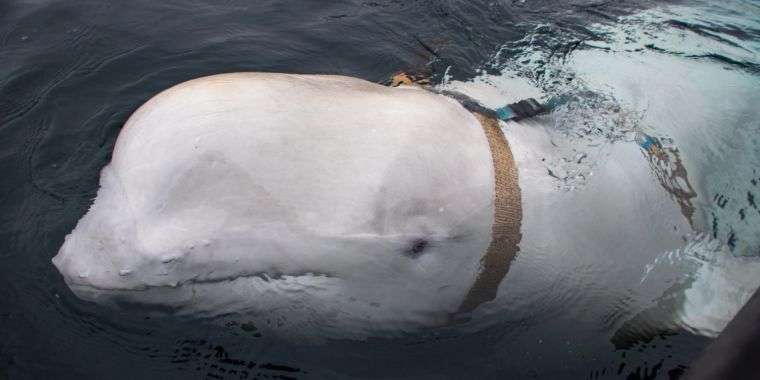
Probable Russian Navy covert camera whale discovered by Norwegians

-
A beluga whale discovered off Norway’s coast, wearing a harness that had an adapter for a GoPro camera, according to authorities.Norwegian Directorate of Fisheries
-
A Norwegian Directorate of Fisheries team member tries to remove the harness from the whale, who had been hanging around fishing boats.
-
The harness pulled off the whale by a Norwegian fisheries team. It had a label in Russian that said “Equipment St. Petersburg.”Norwegian Directorate of Fisheries
-
The label on a buckle on the harness.
Evidence suggests that the Russian Navy has been looking for new ways to leverage what amounts to the original underwater “drone”—militarized cetaceans. Norwegian fishermen discovered a friendly beluga whale in the Barents Sea off the northeast coast of Norway on April 25. Belugas are native to the Barents, so the whale’s presence wasn’t the surprise—the surprise was that it was fitted with a camera harness with Russian markings.
The beluga kept approaching fishing boats and rubbing against them in an apparent effort to remove the harness. After failed attempts to remove the harness themselves, fishermen sent photos to a marine biologist with Norway’s Directorate of Fisheries, and they reported that the whale was in distress. A Fisheries boat was in the area and responded, as reported by a Directorate of Fisheries spokesperson on Facebook:
The Directorate of Fisheries’ oversight boat Rind was in the area and was asked to assist to release the whale for the tight straps. The crew of the Marine Service are trained to free whales from ropes and fishing gear. After a little lure with cod fillets, and with the fisherman Joar Hesten getting into the water wearing a survival suit, the inspectors Jørgen Ree Wiig and Yngve Larsen from the Marine Service and the Horse managed to release the whale…
The whale has probably escaped from Russia where it may have been trained to perform different missions such as underwater photography.
The harness was reportedly marked with the label “Equipment St. Petersburg” and had an attachment point for a GoPro camera. Audun Rikardsen, a professor at the Norwegian Arctic University in Tromsø (UiT), told Norway’s VG that neither Norwegian nor Russian academic researchers put harnesses on whales. “I have been in contact with some Russian researchers,” Rikardsen said. “They can confirm that it is nothing they are doing. They tell me that most likely is the Russian Navy in Murmansk.”
Military marine mammals
On April 29, Dmitry Glazov, the deputy head of the Beluga program at the AN Severtsov Institute of the Russian Academy of Sciences, confirmed to Interfax News Service that the Russian military has been working with beluga whales, but he said that it was not known whether the whales could be used for reconnaissance or intelligence operations. The whales were used for security work during the Sochi Olympics, he noted.
“There is an institute in St. Petersburg that cooperates with the military in studying animals for applied purposes, and it works in the Cossack Bay on the Black Sea and in Murmansk,” Glazov told Interfax.
Smart, social, and highly trainable marine mammals have long been used for a wide variety of research, and the militaries of the world have explored ways of leveraging those characteristics for wartime use at least as far back as the 1960s. A Soviet research program into the use of sea mammals officially ended in 1990, but it apparently lived on long after that. In 2000, the BBC reported that dolphins that had been trained to kill enemy swimmers and attach limpet mines to enemy ships by the Soviet navy had been sold to Iran, along with sea lions, walruses, sea lions, seals, and a beluga whale. Boris Zhurid, a former Soviet submariner who became a dolphin trainer, told the news outlet that four dolphins and the beluga were originally trained by him to attack divers using harpoons mounted on their backs with a harness, or to grab them with their mouths to drag them to the surface for capture. They were also trained as living torpedoes, taught to deliver mines that would explode upon contact with a ship’s hull. The training originally took place at a naval base near Vladivostok, but it moved to Crimea in 1991.
At some point, Russia resumed where the Soviet Union had left off. The program went public in 2017 when the Russian Defense Ministry’s Zvezda television network reported that the Russian Navy was working with a private research institute to train belugas and other marine mammals. According to the Zvezda report, the institute was working to see if whales, seals, and dolphins could be used to “guard entrances to naval bases” and “assist deepwater divers and if necessary kill any strangers who enter their territory.”
Russia is not alone in working to militarize marine mammals. The US Navy’s Marine Mammal Program uses trained bottlenose dolphins and sea lions for a variety of search and recovery missions. Dolphins have been trained to search for and mark submerged mines, and sea lions are used to connect lines to retrieve sunken equipment in places where it’s infeasible to use a human diver. And according to a backgrounder on the program posted by the Naval Information Warfare Center Pacific, which oversees the program, “Both dolphins and sea lions also assist security personnel in detecting and apprehending unauthorized swimmers and divers that might attempt to harm the Navy’s people, vessels, or harbor facilities.”
The Navy insists that unlike in the 1973 movie Day of the Dolphin, marine mammals have never been weaponized.
Beluga abuse
Russia is in the midst of an entirely different cetacean crisis. A facility called the Center of Adaptation for Marine Mammals near Nakhodka—a city east of Vladivostok on the coast of the Sea of Japan—was found in February to be holding 87 belugas and 10 orcas captured from the wild illegally. The facility, uncovered by Russian police, was dubbed a “whale prison” by activists. The whales there were apparently collected for sale to Chinese aquariums.
On April 8, 2019, after pressure from scientists around the world and a direct appeal from French marine researcher Jean-Michel Cousteau, the Russian government agreed to a partnership with Cousteau’s Ocean Futures Society and the Whale Sanctuary Project to rehabilitate all 97 whales and release them into the wild.
Listing image by Norwegian Directorate of Fisheries




